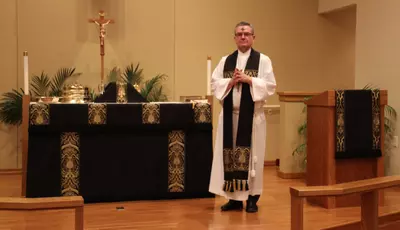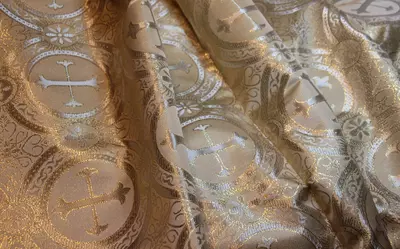Planning – First Steps for Altar Frontal
Planning – First Steps for Altar Frontal
Making an altar frontal is a big undertaking. There are so many things to think about. The list seems endless at times. Here is a brief list of thoughts that start to muddle through the mind and swirl down to the final Ecclesiastical Sewing Project.
Color and Budget
First things first: color and budget. How much money is available to spend. That amount determines the direction of where to begin with fabric selection. Of course, color must be considered and decided as well – what season of the church year is the Altar Frontal intended for, and what Liturgical Colors are appropriate for your church body? There are slight color variations between various churches for the different seasons of the church year. One caution when selecting colors: the Liturgical Colors have a long history within the church. While the Liturgical Colors have an “accepted color range” from which to choose, it is best to stick with true Liturgical colors; and not stray into the realm of “fashion” colors just because one thinks they might look pretty or nice.
Color Guidelines
Color has a powerful influence that ties in with everything else that happens within the church. It has meaning and significance. Major denominations put out color guidelines for use during the church year for a reason. Straying from those colors dilutes the “visual” part of the service from the intended meaning. Now, I know there may be some who disagree with this… and at the risk of offending some, my advice remains the same: to respect the colors assigned to the season of the church year. An example would be using turquoise for Advent. Turquoise is a great color, but it is a “fashion” color, not a liturgical color intended for use during Advent. The reason – Advent is a penitential season. Turquoise is a bright and joyful color, not a penitential color.

Liturgical Green
Liturgical fabrics can span a wide range of prices. The fabrics and trims used in this black set were on the moderate to high end of the price range.
This green set was created on a tight budget. The fabric is a very nice wool crêpe, bought on clearance. It was one of those once-in-a-lifetime bargain finds which was perfect a green altar frontal for the ordinary times. Although the color here appears more of a jade green, the color really is the proper liturgical green color.

Budget-Friendly Options
There are many people out there who might be interested in trying to make a full altar frontal and superfrontal, but fear using the Ecclesiastical fabrics that cost $80 to $200 per yard for a first project. So, what alternatives might be available for those not wanting to jump in over their head financially on a first project? The above fabric was purchased while on vacation last summer. This fabric was found in a chain fabric store in Great Falls, MT, quite by accident. The fabric is gold, and shiny, and has a circle and cross as part of the Liturgical design. It normally retails for about $20 per yard, but with a coupon, it was purchased for about $10 per yard. If a mistake is made while cutting or sewing with this fabric, it is not the end of the world.
What is the difference between this fabric and a more expensive liturgical fabric one might ask? That is a question best answered in another post.
Given the colors of the above fabric are gold and white, it is appropriate for use during a festive season such as Easter or Christmas. The fabric of choice to use with the above Ecclesiastical Brocade will be Silk Dupioni.
Other fabric options would work, but these two fabrics fit the budget as well as the look for this Ecclesiastical Sewing Project. A word of caution about fabric selection: It is best to avoid a fabric that is too shiny or looks too much like a bridal fabric.
Scale Drawing

The next step I usually take before embarking on a major project such as an altar frontal and superfrontal (the narrow piece that hangs from the top edge of the altar, down about 9″ to 13″) is to make a plan. I pull out the graph paper and work the process out on paper before starting with fabric. The altar size for my church is 72″ wide and 39″ high. It is not a big altar, but it is big enough for my sewing space. I start with the outline of the finished size, then think about any designs that might be used. The central design is positioned on the frontal (the part that hangs from the top edge of the altar to the floor).
Design ideas for use on the supperfrontal (Super comes from the Latin – Supra – which means above, the piece that is above the frontal that is 9 to 13″ long) are roughed in on the plan. Next comes the measuring for fringe and orphreys. These design details are drawn into the actual inch in detail.
Preparing
Placing everything on paper allows for adjustments. The orphrey positions can change. The width of the orphreys can be determined or adjusted based on the pattern dimensions of the fabric. I try to work through potential problems and design issues here first, rather than making a big mistake with cutting the fabric. The plan also serves as a reference for future projects. I can look back and see variations in the placement of orphrey patterns and emblems.
For this altar frontal, the plan is to use two 7″ orphrey bands on either side of the center front. There will be a solid space of white that will be about 9″ wide left between the orphrey bands. In the past, this band or space that was left would be adorned with a host of hand-embroidery designs. For this project, we will have to be content with plain bands of white between the rows of orphreys.
Now there are many more things that must be taken into account, such as the architecture of the church and its furnishings. The distance that the pieces must be viewed from is short or halfway to the back of the cathedral? The list could go on forever, but I must stop for the evening. So, are you ready to make some plans for constructing altar hangings for the church? Share your thoughts below.
Solo Dei Gloria
Be sure to visit our online store front Ecclesiastical Sewing where you may shop for Liturgical Fabrics, altar linen fabrics, church vestment-making patterns, liturgical machine embroidery designs, church vestment trims and notions and so much more. You may also find us on Ecclesiastical Sewing on Facebook, Twitter, and Pinterest. Sign up for our mailing list at the bottom of the page on our online store front and receive a free copy of our Small Linens Booklet as our way of saying thank you for following along.
Ideas for Reusing Older Vestment Pieces
Wish Lists Royal School of Needlework Style
Planning Your Lent Church Vestment Projects: a Liturgical Fabric Review
Working with Liturgical Fabrics: Pattern Matching
Altar Frontals
The Ravages of Time on Ecclesiastical Vestments
Framing Steps
Planning Ahead






 RSS - Posts
RSS - Posts
You must be logged in to post a comment.